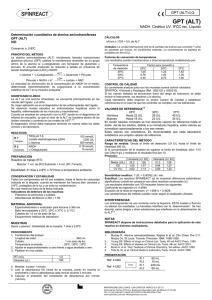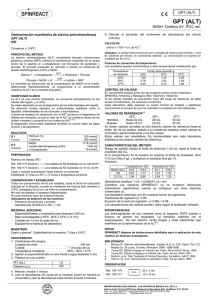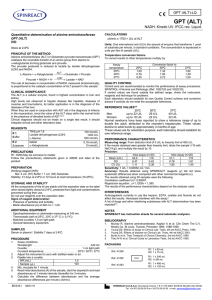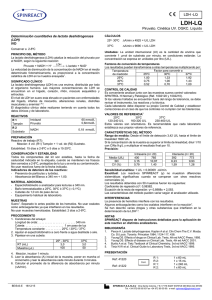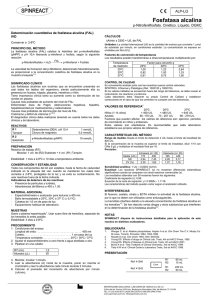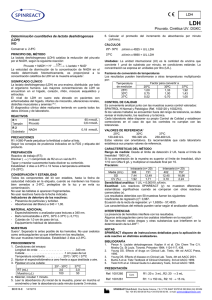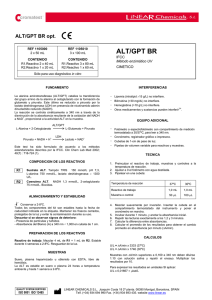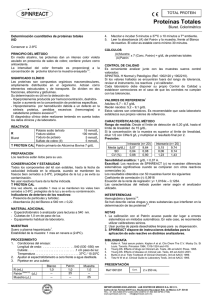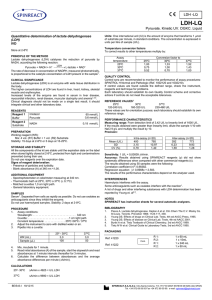Instrucciones de úso
Anuncio
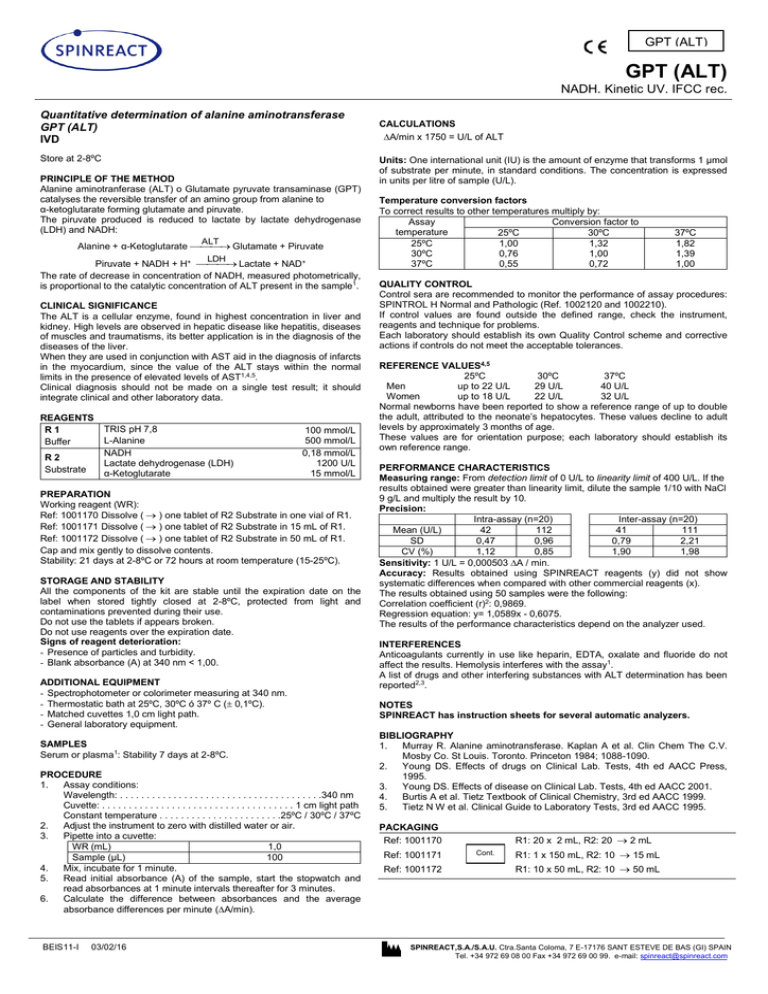
GPT (ALT) GPT (ALT) NADH. Kinetic UV. IFCC rec. Quantitative determination of alanine aminotransferase GPT (ALT) IVD Store at 2-8ºC PRINCIPLE OF THE METHOD Alanine aminotranferase (ALT) o Glutamate pyruvate transaminase (GPT) catalyses the reversible transfer of an amino group from alanine to α-ketoglutarate forming glutamate and piruvate. The piruvate produced is reduced to lactate by lactate dehydrogenase (LDH) and NADH: ALT Alanine + α-Ketoglutarate Glutamate + Piruvate LDH Piruvate + NADH + H+ Lactate + NAD+ The rate of decrease in concentration of NADH, measured photometrically, is proportional to the catalytic concentration of ALT present in the sample1. CLINICAL SIGNIFICANCE The ALT is a cellular enzyme, found in highest concentration in liver and kidney. High levels are observed in hepatic disease like hepatitis, diseases of muscles and traumatisms, its better application is in the diagnosis of the diseases of the liver. When they are used in conjunction with AST aid in the diagnosis of infarcts in the myocardium, since the value of the ALT stays within the normal limits in the presence of elevated levels of AST1,4,5. Clinical diagnosis should not be made on a single test result; it should integrate clinical and other laboratory data. REAGENTS R1 Buffer R2 Substrate TRIS pH 7,8 L-Alanine NADH Lactate dehydrogenase (LDH) α-Ketoglutarate 100 mmol/L 500 mmol/L 0,18 mmol/L 1200 U/L 15 mmol/L PREPARATION Working reagent (WR): Ref: 1001170 Dissolve ( ) one tablet of R2 Substrate in one vial of R1. Ref: 1001171 Dissolve ( ) one tablet of R2 Substrate in 15 mL of R1. Ref: 1001172 Dissolve ( ) one tablet of R2 Substrate in 50 mL of R1. Cap and mix gently to dissolve contents. Stability: 21 days at 2-8ºC or 72 hours at room temperature (15-25ºC). STORAGE AND STABILITY All the components of the kit are stable until the expiration date on the label when stored tightly closed at 2-8ºC, protected from light and contaminations prevented during their use. Do not use the tablets if appears broken. Do not use reagents over the expiration date. Signs of reagent deterioration: - Presence of particles and turbidity. - Blank absorbance (A) at 340 nm < 1,00. ADDITIONAL EQUIPMENT - Spectrophotometer or colorimeter measuring at 340 nm. - Thermostatic bath at 25ºC, 30ºC ó 37º C ( 0,1ºC). - Matched cuvettes 1,0 cm light path. - General laboratory equipment. SAMPLES Serum or plasma1: Stability 7 days at 2-8ºC. PROCEDURE 1. Assay conditions: Wavelength: . . . . . . . . . . . . . . . . . . . . . . . . . . . . . . . . . . . . . .340 nm Cuvette: . . . . . . . . . . . . . . . . . . . . . . . . . . . . . . . . . . . . 1 cm light path Constant temperature . . . . . . . . . . . . . . . . . . . . . . .25ºC / 30ºC / 37ºC 2. Adjust the instrument to zero with distilled water or air. 3. Pipette into a cuvette: WR (mL) 1,0 Sample (µL) 100 4. Mix, incubate for 1 minute. 5. Read initial absorbance (A) of the sample, start the stopwatch and read absorbances at 1 minute intervals thereafter for 3 minutes. 6. Calculate the difference between absorbances and the average absorbance differences per minute (A/min). BEIS11-I 03/02/16 CALCULATIONS A/min x 1750 = U/L of ALT Units: One international unit (IU) is the amount of enzyme that transforms 1 µmol of substrate per minute, in standard conditions. The concentration is expressed in units per litre of sample (U/L). Temperature conversion factors To correct results to other temperatures multiply by: Conversion factor to Assay temperature 25ºC 30ºC 25ºC 1,00 1,32 30ºC 0,76 1,00 37ºC 0,55 0,72 37ºC 1,82 1,39 1,00 QUALITY CONTROL Control sera are recommended to monitor the performance of assay procedures: SPINTROL H Normal and Pathologic (Ref. 1002120 and 1002210). If control values are found outside the defined range, check the instrument, reagents and technique for problems. Each laboratory should establish its own Quality Control scheme and corrective actions if controls do not meet the acceptable tolerances. REFERENCE VALUES4,5 25ºC 30ºC 37ºC Men up to 22 U/L 29 U/L 40 U/L Women up to 18 U/L 22 U/L 32 U/L Normal newborns have been reported to show a reference range of up to double the adult, attributed to the neonate’s hepatocytes. These values decline to adult levels by approximately 3 months of age. These values are for orientation purpose; each laboratory should establish its own reference range. PERFORMANCE CHARACTERISTICS Measuring range: From detection limit of 0 U/L to linearity limit of 400 U/L. If the results obtained were greater than linearity limit, dilute the sample 1/10 with NaCl 9 g/L and multiply the result by 10. Precision: Intra-assay (n=20) Inter-assay (n=20) Mean (U/L) 42 112 41 111 SD 0,47 0,96 0,79 2,21 CV (%) 1,12 0,85 1,90 1,98 Sensitivity: 1 U/L = 0,000503 A / min. Accuracy: Results obtained using SPINREACT reagents (y) did not show systematic differences when compared with other commercial reagents (x). The results obtained using 50 samples were the following: Correlation coefficient (r)2: 0,9869. Regression equation: y= 1,0589x - 0,6075. The results of the performance characteristics depend on the analyzer used. INTERFERENCES Anticoagulants currently in use like heparin, EDTA, oxalate and fluoride do not affect the results. Hemolysis interferes with the assay1. A list of drugs and other interfering substances with ALT determination has been reported2,3. NOTES SPINREACT has instruction sheets for several automatic analyzers. BIBLIOGRAPHY 1. Murray R. Alanine aminotransferase. Kaplan A et al. Clin Chem The C.V. Mosby Co. St Louis. Toronto. Princeton 1984; 1088-1090. 2. Young DS. Effects of drugs on Clinical Lab. Tests, 4th ed AACC Press, 1995. 3. Young DS. Effects of disease on Clinical Lab. Tests, 4th ed AACC 2001. 4. Burtis A et al. Tietz Textbook of Clinical Chemistry, 3rd ed AACC 1999. 5. Tietz N W et al. Clinical Guide to Laboratory Tests, 3rd ed AACC 1995. PACKAGING Ref: 1001170 Ref: 1001171 Ref: 1001172 R1: 20 x 2 mL, R2: 20 2 mL Cont. R1: 1 x 150 mL, R2: 10 15 mL R1: 10 x 50 mL, R2: 10 50 mL SPINREACT,S.A./S.A.U. Ctra.Santa Coloma, 7 E-17176 SANT ESTEVE DE BAS (GI) SPAIN Tel. +34 972 69 08 00 Fax +34 972 69 00 99. e-mail: [email protected] GPT (ALT) GPT (ALT) NADH. Cinético UV. IFCC rec. Determinación cuantitativa de alanina aminotransferasa GPT (ALT) IVD 5. Leer la absorbancia (A) inicial de la muestra, poner en marcha el cronometro y leer la absorbancia cada minuto durante 3 minutos. 6. Calcular el promedio de la diferencia de absorbancia por minuto (A/min). Conservar a 2-8ºC CÁLCULOS A/min x 1750 = U/L de ALT PRINCIPIO DEL MÉTODO La alanina aminotrasferasa (ALT) inicialmente llamada transaminasa glutámico pirúvica (GPT) cataliza la transferencia reversible de un grupo amino de la alanina al α-cetoglutarato con formación de glutamato y piruvato. El piruvato producido es reducido a lactato en presencia de lactato deshidrogenasa (LDH) y NADH: Unidades: La unidad internacional (UI) es la cantidad de enzima que convierte 1 µmol de substrato por minuto, en condiciones estándar. La concentración se expresa en unidades por litro (U/L). ALT Alanina + α-Cetoglutarato Glutamato + Piruvato LDH Piruvato + NADH + H+ Lactato + NAD+ La velocidad de disminución de la concentración de NADH en el medio, determinado fotometricamente, es proporcional a la concentración catalítica de ALT en la muestra ensayada1. SIGNIFICADO CLÍNICO La ALT es una enzima intracelular, se encuentra principalmente en las células del hígado y el riñón. Su mejor aplicación es en el diagnóstico de las enfermedades del hígado. Se observan niveles elevados en enfermedades hepáticas como la hepatitis, enfermedades de los músculos y traumatismos. Cuando se emplean en conjunción con la AST ayuda en el diagnóstico de infartos de miocardio, ya que el valor de la ALT se mantiene dentro de los límites normales y aumenta en los niveles de AST1,4,5. El diagnostico clínico debe realizarse teniendo en cuenta todos los datos clínicos y de laboratorio. REACTIVOS R1 Tampón R2 Substrato TRIS pH 7,8 L-Alanina NADH Lactato deshidrogenasa (LDH) α-Cetoglutarato 100 mmol/L 500 mmol/L 0,18 mmol/L 1200 U/L 15 mmol/L PREPARACIÓN Reactivo de trabajo (RT): Ref: 1001170 Disolver ( ) un comprimido de R2 Substrato en un vial de R1. Ref: 1001171 Disolver ( ) un comprimido de R2 Substrato en 15 mL de R1. Ref: 1001172 Disolver ( ) un comprimido de R2 Substrato en 50 mL de R1. Tapar y mezclar suavemente hasta disolver su contenido. Estabilidad: 21 días a 2-8ºC o 72 horas a temperatura ambiente (15-25ºC). CONSERVACIÓN Y ESTABILIDAD Todos los componentes del kit son estables, hasta la fecha de caducidad indicada en la etiqueta, cuando se mantienen los frascos bien cerrados a 2-8ºC, protegidos de la luz y se evita su contaminación. No usar las tabletas si aparecen fragmentadas. No usar reactivos fuera de la fecha indicada. Indicadores de deterioro de los reactivos: - Presencia de partículas y turbidez. - Absorbancia del Blanco a 340 nm < 1,00. MATERIAL ADICIONAL - Espectrofotómetro o analizador para lecturas a 340 nm. - Baño termostatizable a 25ºC, 30ºC ó 37ºC ( 0,1ºC) - Cubetas de 1,0 cm de paso de luz. - Equipamiento habitual de laboratorio. MUESTRAS Suero o plasma1. Estabilidad de la muestra: 7 días a 2-8ºC. PROCEDIMIENTO 1. Condiciones del ensayo: Longitud de onda: . . . . . . . . . . . . . . . . . . . . . . . . . . . . . . . . 340 nm Cubeta:. . . . . . . . . . . . . . . . . . . . . . . . . . . . . . . . . .1 cm paso de luz Temperatura constante: . . . . . . . . . . . . . . . . . . . . 25ºC / 30ºC / 37ºC 2. Ajustar el espectrofotómetro a cero frente a agua destilada o aire. 3. Pipetear en una cubeta: RT (mL) 1,0 Muestra (µL) 100 4. Mezclar, incubar 1 minuto. BEIS11-E 03/02/16 Factores de conversión de temperaturas Los resultados pueden transformarse a otras temperaturas multiplicando por: Factor para convertir a Temperatura de medición 25ºC 30ºC 37ºC 25ºC 1,00 1,32 1,82 30ºC 0,76 1,00 1,39 37ºC 0,55 0,72 1,00 CONTROL DE CALIDAD Es conveniente analizar junto con las muestras sueros control valorados: SPINTROL H Normal y Patológico (Ref. 1002120 y 1002210). Si los valores hallados se encuentran fuera del rango de tolerancia, se debe revisar el instrumento, los reactivos y la técnica. Cada laboratorio debe disponer su propio Control de Calidad y establecer correcciones en el caso de que los controles no cumplan con las tolerancias. VALORES DE REFERENCIA4,5 25ºC 30ºC 37ºC Hombres Hasta 22 U/L 29 U/L 40 U/L Mujeres Hasta 18 U/L 22 U/L 32 U/L En recién nacidos normales se han descrito valores de referencia hasta el doble del de los adultos, debido a su inmadurez hepática, estos valores se normalizan aproximadamente a los tres meses. Estos valores son orientativos. Es recomendable que cada laboratorio establezca sus propios valores de referencia. CARACTERÍSTICAS DEL MÉTODO Rango de medida: Desde el límite de detección 0 U/L hasta el límite de linealidad 400 U/L. Si la concentración de la muestra es superior al límite de linealidad, diluir 1/10 con ClNa 9 g/L y multiplicar el resultado final por 10. Precisión: Intraserie (n= 20) Interserie (n= 20) Media (U/L) 42 112 41 111 SD 0,47 0,96 0,79 2,21 CV (%) 1,12 0,85 1,90 1,98 Sensibilidad analítica: 1 U/L = 0,000503 A / min. Exactitud: Los reactivos SPINREACT (y) no muestran diferencias sistemáticas significativas cuando se comparan con otros reactivos comerciales (x). Los resultados obtenidos con 50 muestras fueron los siguientes: Coeficiente de regresión (r)2: 0,9869. Ecuación de la recta de regresión: y= 1,0589x - 0,6075. Las características del método pueden variar según el analizador utilizado. INTERFERENCIAS Los anticoagulantes de uso corriente como la heparina, EDTA oxalato o fluoruro no afectan los resultados. La hemólisis interfiere con la determinación1. Se han descrito varias drogas y otras substancias que interfieren en la determinación de la ALT2,3. NOTAS SPINREACT dispone de instrucciones detalladas para la aplicación de este reactivo en distintos analizadores. BIBLIOGRAFÍA 1. Murray R. Alanine aminotransferase. Kaplan A et al. Clin Chem The C.V. Mosby Co. St Louis. Toronto. Princeton 1984; 1088-1090. 2. Young DS. Effects of drugs on Clinical Lab. Tests, 4th ed AACC Press, 1995. 3. Young DS. Effects of disease on Clinical Lab. Tests, 4th ed. AACC 2001. 4. Burtis A. et al. Tietz Textbook of Clinical Chemistry, 3rd edition. AACC 1999. 5. Tietz N. W. et al. Clinical Guide to Laboratory Tests, 3rd ed. AACC 1995. PRESENTACIÓN Ref: 1001170 Ref: 1001171 Ref: 1001172 R1: 20 x 2 mL ,R2: 20 2 mL Cont. R1: 1 x 150 mL, R2: 10 15 mL R1: 10 x 50 mL, R2: 10 50 mL SPINREACT,S.A./S.A.U. Ctra.Santa Coloma, 7 E-17176 SANT ESTEVE DE BAS (GI) SPAIN Tel. +34 972 69 08 00 Fax +34 972 69 00 99. e-mail: [email protected]
